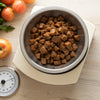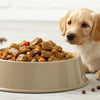How Much Wet Dog Food for a 20 lb Dog: A Comprehensive Guide
- Houndsy
Table of Contents
- Introduction
- The Importance of Proper Feeding for Dogs
- Understanding Wet Dog Food Feeding Guidelines
- Factors Influencing Wet Dog Food Portions for a 20 lb Dog
- Benefits of Incorporating Wet Dog Food
- Adjusting Portions When Mixing Wet and Dry Food
- Our Approach at Houndsy
- Conclusion
- Frequently Asked Questions (FAQ)
Introduction
Did you know that nearly 60% of dogs in the United States are classified as overweight or obese? This alarming statistic underscores the importance of properly understanding our furry friends' nutritional needs, especially regarding how much wet dog food to feed them daily. As loving pet owners, we often want to give our dogs the best, but with so many options, knowing the right amount of wet food can be challenging. Accurate portioning not only nourishes our pets but also significantly impacts their overall health and happiness.
In this blog post, we will dive into the intricacies of dog feeding, focusing specifically on how much wet dog food is appropriate for a 20 lb dog. We will explore factors influencing portion sizes, examine guidelines for wet food, highlight the benefits of wet dog food, and how our innovative Houndsy Kibble Dispenser fits into this equation. By the end of this article, we hope to empower you with the knowledge needed to determine the optimal amount of wet dog food your dog should consume while enhancing your feeding routine.
Let’s embark on this journey together, ensuring our beloved pets receive the best care while simplifying our lives as pet parents!
The Importance of Proper Feeding for Dogs
Feeding your dog the right amount of food is paramount for their health and well-being. Inadequate or excessive food intake can lead to critical nutritional issues. Here’s a deeper look into why proper feeding matters:
Consequences of Overfeeding
Overfeeding your dog can lead to obesity, which is associated with many health problems, including:
- Joint issues: Excess weight can strain your dog's joints, potentially leading to arthritis and other orthopedic conditions.
- Diabetes: Overweight dogs are at higher risk of developing diabetes.
- Shortened lifespan: Obesity can reduce a dog's quality of life and lifespan.
Consequences of Underfeeding
On the other hand, underfeeding can result in nutritional deficiencies that impact your dog's energy levels, immune function, and overall health. Over time, this can lead to:
- Weight loss: Insufficient calories can lead to unhealthy weight loss.
- Skin and coat problems: Dogs may develop dull fur or skin issues due to lack of essential fatty acids or vitamins.
- Lethargy: Without adequate nutrition, your dog may appear sluggish and unenergetic.
Role of Proper Portioning
To avoid these issues, understanding portion sizes based on your dog’s weight, age, health status, and activity level is crucial. With a tailored feeding approach, you can ensure your dog thrives.
Understanding Wet Dog Food Feeding Guidelines
Feeding guidelines provide a valuable starting point for understanding how much wet dog food to offer your pet. Generally, most brands specify their recommendations on the packaging, which can vary based on calorie density.
General Wet Food Recommendations
For a 20 lb dog, typical wet dog food feeding guidelines suggest:
- 1 can (typically 12.5 oz) per 10-15 pounds of body weight per day.
- For a 20 lb dog, this equates roughly to 1-1.5 cans per day, depending on the brand's specifics and your dog's activity level.
These figures serve as a baseline and should be adjusted based on your dog’s individual characteristics.
Example Calculation
If we consider our 20 lb dog:
- If we adhere to the 1 can per 15 lbs guideline, that translates to approximately 1.33 cans per day.
- If you feed your dog twice a day, simply divide this amount:
- Daily Total: 1.33 cans
- Per Meal: About 2/3 can (roughly 6 oz) each feeding.
By monitoring your dog’s weight and adjusting portions as necessary, you can maintain optimal health.
Factors Influencing Wet Dog Food Portions for a 20 lb Dog
Several factors must be considered when determining how much to feed your dog. These include:
1. Activity Level
A dog's caloric needs can vastly differ based on how active they are. For example, an active 20 lb dog may need up to 20-30% more calories than a sedentary dog. If your dog enjoys long walks or playtime, you may need to increase their food portions slightly.
2. Age and Life Stage
- Puppies: Require more calories due to rapid growth. For a 20 lb puppy, consider following a puppy-specific formula to ensure balanced growth.
- Adult Dogs: Like our 20 lb example, expect steady intake.
- Senior Dogs: They may require fewer calories due to reduced activity but should still have adequate nutrition and hydration.
3. Health Status
If your dog has specific health concerns (like diabetes or kidney disease), consult your veterinarian for tailored feeding recommendations. Some health conditions necessitate a specialized diet, influencing how much wet food they should consume.
4. Type of Wet Food
Wet foods vary in caloric density. Premium brands with higher protein may require less by weight compared to others. Always check the feeding guide for the specific product.
Benefits of Incorporating Wet Dog Food
Understanding why to include wet dog food in your pet's diet is essential. Here are several benefits:
1. Increased Palatability
Many dogs find wet food more appealing, thanks to its aroma and texture. This is especially helpful for picky eaters or dogs with dental issues that make chewing dry kibble difficult.
2. Hydration
Wet food offers higher moisture content, promoting better hydration. This is especially crucial in warmer months or for dogs that may not drink enough water.
3. Nutritional Variety
Incorporating wet food might provide additional nutrients, including different protein sources and added vitamins. Mixing wet with dry food can enhance your dog’s overall diet.
4. Convenience
Wet food can simplify meal preparation. It is easy to serve and can be stored appropriately in larger quantities, making it an excellent choice for busy pet owners.
Adjusting Portions When Mixing Wet and Dry Food
Many pet owners find the benefits of mixing wet and dry food appealing. However, adjusting portions properly is essential to avoid overfeeding.
Guidelines for Mixing Wet and Dry Food
When you add wet food to your dog’s diet:
- Consider reducing dry food portions to account for the extra calories from the wet food.
- A common guideline is to subtract 1/3 cup of kibble for every 1/2 can of wet food added.
Balancing Nutritional Intake
Keep an eye on your dog's weight and energy levels to ensure their mixed diet supports their overall health. Adjust as necessary for the right balance.
Our Approach at Houndsy
At Houndsy, we dedicate our efforts to enhancing the feeding experience for pet owners and their beloved dogs. Our flagship product, the Houndsy Kibble Dispenser, combines innovative design with functional benefits that can transform your daily feeding routine.
Key Features of the Houndsy Kibble Dispenser
- Convenient Crank: Effortlessly dispense the right portion without bending down, preserving your back while keeping mealtime pleasant.
- Beautiful Design: With its mid-century modern aesthetic, it fits seamlessly into your home decor while serving its purpose smoothly.
- Large Storage Capacity: Designed to hold 25-30 lbs of kibble, reducing the frequency of refills, whether for dry or mixed food.
- BPA-Free Liner: Ensures food remains fresh and safe for your pet.
- Auto-Locking Mechanism: Prevents accidental dispensing by inquisitive pets or toddlers, keeping mealtime organized.
Explore the features and find out how the Houndsy Kibble Dispenser can fit into your pet care routine by checking it out here.
Conclusion
Understanding how much wet dog food to feed your 20 lb dog is essential for their well-being. By factoring in their weight, age, activity level, and health status, you can determine the right portion sizes and give your dog the best chance at a healthy, happy life.
We at Houndsy are passionate about simplifying the pet feeding experience to be enjoyable and stress-free. Our innovative products, like the Houndsy Kibble Dispenser, bring both style and functionality to your dog feeding routine.
As you reflect on and adjust your feeding practices, remember that consistency and quality are keys to keeping your furry friend in peak condition.
Frequently Asked Questions (FAQ)
-
How do I determine the right amount of wet dog food for my dog? Start by referencing the feeding guidelines on your dog food packaging based on your dog’s weight and adjust according to their activity level and age.
-
Can I mix wet dog food with dry food? Absolutely! Combining wet and dry food can enhance palatability and increase hydration. Just be sure to account for total calorie intake.
-
How often should I feed my dog wet food? Most adult dogs benefit from two meals of wet food daily, but puppies may need more frequent feeding.
-
What should I do if my dog is gaining weight? If you notice weight gain, consult with your veterinarian to create a tailored plan that may involve reducing food portions and increasing physical activity.
-
Is the Houndsy Kibble Dispenser suitable for wet dog food storage? While primarily designed for dry food, it can also hold wet food if stored appropriately to maintain freshness.
Feeding your pet should be a delightful experience, and we aim to help you achieve that! If you’re ready to elevate your dog feeding routine, we invite you to learn more about the Houndsy Kibble Dispenser here.












